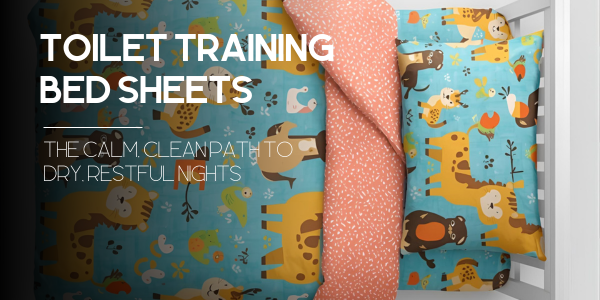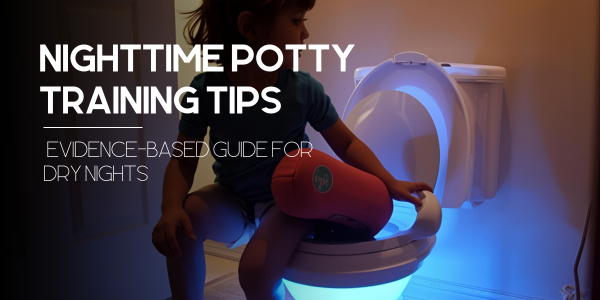Bedwetting in Children: A Positive, Forward-Thinking Guide
Waking Up to a New Conversation: Rethinking Bedwetting in Children
Four-year-old Maya felt her heart hammer when she woke to damp sheets. The fear wasn’t just about wet pajamas—it was the silent dread that her parents might be upset, even though deep down she knew they loved her fiercely. Parents, you know this story all too well: the instant rush of guilt, the whisper that maybe you missed a cue. But here’s the truth: bedwetting in children is not a moral failing—it’s simply a signal that your child’s body and mind are still learning to coordinate. And by reimagining our approach, we can turn those frantic midnight laundry runs into moments of compassion, understanding, and progress.
At Chooniez, we’re leading a quiet revolution—challenging the outdated notion that bedwetting belongs in the shadows. It’s time to shine a light on nocturnal enuresis, transforming shame into empowerment for families everywhere. Imagine a world where “wet night” charts are celebrated milestones of improvement rather than stamped badges of failure.
Understanding the Child’s Perspective of Bed Wetting
Bedwetting often feels like a betrayal: your child, who can stay dry during the day, suddenly loses control at night. Picture little Noah, who proudly zips up his pants at preschool. Then bedtime comes—he drifts into a deep, dreamless sleep, too deep to register his bladder’s signals. When he stirs at dawn, the wet spot on his sheets sends him rushing to the bathroom in shame. That fleeting moment of panic? It can echo through the day, shaping self-esteem and family dynamics. But when you pause, breathe, and remind yourself that this is simply part of many children’s developmental timelines, you open the door to transformative conversations.
Shattering Isolation
Parents often feel alone—like the only family grappling with damp pajamas and laundry nightmares. Yet studies show that up to 15% of seven-year-olds experience bedwetting on any given night. Those numbers alone should be enough to rewrite the narrative: bedwetting is pervasive. By sharing stories—like the one Kim, a mom of twins, told us: “I thought we were failing until I joined a support group and realized hundreds of parents were in my shoes!”—we create a community built on solidarity, not judgment.
Driving Dialogue, Inspiring Change
It’s time to break the silence. Our brand was born from a single mission: to make bedwetting and incontinence products approachable, even uplifting, rather than clinical or embarrassing. Through our “Leak-Less Library,” we publish articles that blend science, empathy, and practical guidance. For example, our guide on how to talk to kids about bed-wetting reframes bedtime accidents as teachable moments—offering scripts that let you speak from a place of calm authority.
Vision for a Stigma-Free Tomorrow
Imagine every parent confidently ordering an ultra-soft bed-wetting throw blanket without a whisper of embarrassment. Picture children excited to try our organic sleeping bag for incontinence—a fun, cozy accessory that turns a potential crisis into a simple nighttime ritual. That’s the world we’re building: one where design, technology, and human-first language converge to move families from crisis mode into a confident, step-by-step journey toward dryness.
Whether you’re a parent awake at 2 a.m. googling “bedwetting sheets” or a grandparent searching for answers, we invite you to explore our full line of solutions in our collections. We’ve designed everything from breathable pads to moisture-sensing pajamas—so no child feels left behind.
Explore Chooniez SolutionsLifting the Lid on Nocturnal Enuresis: What Every Parent Should Know
You’ve likely heard whispers: “She’ll outgrow it.” Or “Just give it time.” But what if those well-meaning assurances are masking a deeper understanding? Bedwetting—medically known as nocturnal enuresis—is not a random quirk; it’s a symphony of developmental factors playing out while your child sleeps. By grasping the science behind enuresis, you can fast-track solutions, reduce anxiety, and foster a sense of mastery for your son or daughter.
“Bedwetting” vs. “Enuresis” vs. “Incontinence”
Words carry weight. When you say “incontinence,” it feels more clinical—like an adult diagnosis. But “bedwetting” often sounds childish, even dismissive. Enter “nocturnal enuresis”: the precise, respectful term used by pediatric experts.
• Primary Enuresis: When a child has never achieved a six-month stretch of dry nights. • Secondary Enuresis: When a child wets the bed after at least six months of dryness.
Recognizing these distinctions helps you and your pediatrician tailor an approach—whether that’s alarm therapy, behavioral adjustments, or medical evaluation. When you speak in accurate terms, you frame the issue as “something to solve,” not “something to hide.”
Why Language Shapes Outcomes
Studies show that parents who adopt neutral, medically accurate language about nocturnal enuresis create less anxiety in their children. A child who hears “You experienced primary enuresis, but your body is still learning” is far less likely to internalize shame than one who hears “You’re a bedwetter.” By shifting the narrative, you set a tone of collaboration, not blame.
2. Prevalence and Statistics of Bed Wetting In Childern
Bedwetting by Age Group
| Age | Approximate Percentage Wetting at Night |
|---|---|
| 3–4 years | 20–30% |
| 5–6 years | 15–20% |
| 7–8 years | 10–15% |
| 9–10 years | 5–10% |
| Adolescents (11–17 years) | 1–3% |
Those numbers matter. Think about Jackson, age 8, whose parents worried they were the only ones still washing sheets nightly. In reality, nearly one in seven children his age experience enuresis. Knowing the stats dismantles that sense of isolation. It also underscores why seeking professional advice—rather than waiting for “time to fix it”—can accelerate your child’s progress.
Gender Differences: Boys vs. Girls
On average, boys are slightly more prone to bedwetting than girls—roughly a 2:1 ratio after age six. Why? Experts point to slower maturation of the bladder’s muscle tone and neurological pathways in boys. But remember: these are general trends. Your daughter might continue to have occasional wet nights well into elementary school, and that’s still within the realm of normal development.
Global Perspective: Culture & Incidence
Around the world, attitudes toward pediatric incontinence vary widely. In some cultures, enuresis is perceived as a spiritual test; in others, it’s framed as a medical issue that demands immediate intervention. For parents raising bicultural children, these conflicting messages can feel bewildering. That’s why Chooniez’s approach is to combine evidence-based science with culturally sensitive guidance—empowering every family, no matter their background, to choose solutions that resonate with their values.
As you explore these facts, remember: advances in science and technology are reshaping what’s possible. From moisture-sensing alarm designs to AI-driven behavior trackers, the future of bedwetting care is bright—and it starts with awareness.
Curious about nighttime confidence boosts? Read our deep dive on why innovative bed sheets for bed-wetting are changing nighttime confidence.
Debunking Bedwetting Myths: Separating Fact from Fiction
“Why is Tommy still wet at night?” If only there were a simple answer—yet countless misconceptions swirl around bedwetting like rumors at a playground. Let’s sweep away these myths once and for all, replacing them with clarity, compassion, and confidence. By understanding the truth, you’re already on the path toward turning midnight worries into sunrise triumphs.
Myth 1: “Bedwetting Is Just Laziness or Willful Disobedience”
The Reality: Complexity Over Character
Picture Emma, who aces potty training by age two—and then, out of the blue, wets the bed at age five. Some might think, “She’s just too lazy to get up.” In truth, neurological development dictates when a child can detect a full bladder during sleep. Many kids simply haven’t built the connection between bladder signals and waking up. It’s neither laziness nor defiance—it’s biology catching up.
Our guide on talking to kids about bed-wetting teaches you how to speak from a place of understanding, ensuring your child knows it’s not a moral lapse—just a phase they’ll outgrow with the right support.
Myth 2: “Kids Always Outgrow Bedwetting on Their Own”
Patience Isn’t Always the Only Solution
It’s true: many children naturally achieve nighttime dryness by age seven or eight. But here’s the catch—waiting passively can stretch weeks into months or even years, increasing anxiety for both child and parent. Early interventions—like moisture alarms or structured bladder training—can speed progress.
| Scenario | Passive Waiting | Guided Intervention |
|---|---|---|
| Average Time to Dry Nights | 12–18 months | 3–6 months |
| Emotional Impact | Higher frustration & low self-esteem | Increased confidence & sense of agency |
| Family Stress | Persistent laundry cycles, bedtime dread | Structured plan reduces nighttime crises |
If you’re tired of endless sheet changes, explore our insights on why bed-wetting sheets are game changers. These aren’t just waterproof covers—they’re confidence boosters that let your child wake up knowing you’ve got their back.
Myth 3: “Punishment Works—Make Them Feel Guilty, and They’ll Stop”
Shame Isn’t a Strategy
Imagine scolding your child for something their body isn’t fully controlling. Guilt and shame, far from motivating, can erode self-worth. Instead, switch to positive reinforcement: celebrate every dry night with a high-five, sticker chart, or small reward. When nighttime success is framed as something to be praised, your child’s brain begins to associate “I can do this” with bedtime rituals, rather than “I’m a failure.”
Curious about transforming discipline into encouragement? Check out how incontinence chair pads (yes, they exist for kids!) can remove one more source of stress. When cleanup is simple, blame loses its hold.
By dismantling these myths, you clear the runway for progress—and help your child land softly on the path to dry nights. Remember: bedwetting is a developmental stage, not a moral failing. Every myth debunked is a step toward healthier, happier mornings.
Browse Confidence-Boosting SolutionsThe Science Behind Sleepless Nights: Uncovering Causes
Midnight wetness doesn’t stem from a single culprit; it’s a symphony of genetics, hormones, neurology, and emotions. By diving into the science, you become an empowered advocate—armed with knowledge to accelerate your child’s journey to dry nights. Let’s unravel these layers and see how each plays its part.
Genetic Predisposition
The Family Tree Factor
Ever heard the saying, “Like parent, like child”? Turns out, up to 70% of children who wet the bed have at least one parent who did too. That’s not to say it’s inevitable—rather, it’s a clue. Genetic markers related to bladder control and sleep-pattern regulation can be passed down, making some kids biologically wired to take longer to achieve nighttime dryness.
| Parental Bedwetting History | Likelihood Child Will Wet Bed |
|---|---|
| Neither parent | 15% |
| One parent | 44% |
| Both parents | 77% |
This data doesn’t spell doom—it spells opportunity. Knowing your child’s genetic predisposition means you can start targeted strategies earlier, reducing unnecessary worry and speeding up improvements.
Neurological & Developmental Factors
When Brains Don’t Wake for Bladders
Some children experience deep, restorative sleep so intense that they miss bladder signals altogether. Their neurological wiring hasn’t yet fine-tuned the “wake up” alarm. MRI studies reveal that certain regions of the brain responsible for arousal during a full bladder develop at different paces in different kids.
For examples of cutting-edge insights, visit our Science & Technology hub, where pediatric neurologists explain how sleep-stage research is revolutionizing bedwetting treatments. Imagine a future where wearable headbands predict when a child’s brain needs to rouse them—telemetry that could reduce the need for bulky alarms.
Hormonal Influences: ADH and Beyond
The Nighttime Water Regulator
Antidiuretic hormone (ADH) naturally spikes at night in adults, telling kidneys to produce less urine. In many children who wet the bed, those ADH surges are muted or poorly timed. The result? An overactive nighttime bladder.
Pediatric urologists sometimes prescribe desmopressin (DDAVP) to mimic ADH, reducing nighttime urine volume by up to 50%. But every child’s hormonal rhythm is unique—so dosing requires careful titration to avoid headaches or low sodium complications. Today’s research is exploring next-generation peptide analogs that could fine-tune ADH responses with fewer side effects, opening doors to personalized medicine for enuresis.
Psychological & Emotional Triggers
When Worries Leak into Sleep
Stress isn’t just a grown-up problem. Children undergoing transitions—new schools, sibling rivalry, even a big birthday—can experience anxiety that manifests as bedwetting. Consider Jenna, whose nighttime accidents began after her dog passed away. Her body’s stress response disrupted sleep architecture, making it harder to register bladder fullness.
While we often associate adult bedwetting with anxiety, kids aren’t immune. (Yes, even adults can regress—learn more about stress-induced enuresis in adults.) For children, trauma-informed counseling can address emotional undercurrents, enabling both mind and bladder to find calm.
Medical Conditions & Comorbidities
When Underlying Health Hides in Plain Sight
Not all bedwetting is “just developmental.” Urinary tract infections (UTIs), diabetes, constipation, and sleep apnea can all present as nighttime accidents. That’s why a simple pediatrician visit—complete with urine analysis and, if indicated, an ultrasound—becomes critical. Early detection of a UTI, for instance, can alleviate pain and halt recurrent enuresis.
If daytime accidents accompany bedwetting, that’s a red flag shouting “See a specialist.” Comorbid ADHD or autism spectrum disorders also correlate with higher enuresis rates, so a multidisciplinary approach—enlisting pediatricians, urologists, and psychologists—ensures you’re not just treating the symptom but the whole child.
By understanding these multifaceted causes—genetic, neurological, hormonal, emotional, and medical—you step into a proactive stance. You’re no longer waiting for “something to happen.” You’re making it happen: diagnosing, treating, and ultimately, celebrating the day your child wakes up dry.
Discover Expert-Designed Incontinence SolutionsBuilding Confidence at Night: Holistic Behavioral Strategies
There’s magic in a child’s smile when they wake up dry—an affirmation that their body and mind are working together. Creating that morning victory begins long before bedtime. By weaving in behavioral techniques that honor your child’s pace, you transform anxiety-laden nights into empowering rituals. Let’s explore how to build a fortress of confidence, one small step at a time.
Bladder Training Techniques
Timed Voiding: Structuring Relief
Instead of leaving things to chance, institute a simple schedule: encourage your child to use the bathroom every two hours. Yes, every two hours—even if they say they don’t need to go. Over several weeks, this consistent pattern teaches the bladder to hold gradually larger volumes, strengthening control. To kickstart progress:
- Keep a colorful clock or timer at eye level. Make bedtime “potty time” a non-negotiable appointment.
- Record successes: when your child pees on schedule, cross off a star on a reward chart.
- Sensory cues help: a gentle beep or fun ringtone reminds them to go, even during play.
As muscles learn to stretch and release at the right time, accidents become less common—and confidence soars.
Pelvic Floor “Play” Exercises
Imagine turning pelvic floor strengthening into a game. Ask your child to pretend they’re stopping and starting the flow of water midstream—squeezing those muscles for a count of five, then relaxing for five. Repeat ten times. Doing this twice daily, perhaps with silly animal noises (bear, bunny, tiger), transforms exercise into fun. Over time, stronger pelvic muscles help signal the brain when it’s truly urgent, not a false alarm.
Positive Reinforcement & Reward Systems
Celebrating Dry Nights
When your child wakes to dry sheets, it’s not just a coincidence—it’s a milestone. Instead of a verbal high-five, make it tangible: a sticker on a chart, a hero badge, or a small toy token. As these rewards accumulate, the chart itself becomes a visual testament to their progress. Avoid monetary or food-based incentives; instead, choose experiences—an extra story at bedtime, a mini-dance party in the living room, or picking the family’s weekend game.
Each celebration, no matter how modest, reinforces: “I can do this.” And soon, they’ll associate bedtime with possibility rather than dread.
Gentle Check-Ins Over Judgment
On nights with an accident, resist scolding. Instead, offer reassurance: “Your body’s learning. Tonight was a step toward tomorrow’s dry morning.” Use soothing language—no blame. When you maintain a calm, factual tone, your child’s self-esteem remains intact. For practical cleanup tips that keep nighttime stress low, see our mattress cleaning guide. Efficient cleanup prevents dread—and preserves positivity.
Bedtime Routines & Sleep Hygiene
Crafting the “Wind-Down Ritual”
A scattered evening schedule often leads to deep, unfocused sleep where bladder signals go unnoticed. Instead, design a calming ritual:
- Dim the Lights: Lower light levels one hour before bed to cue melatonin production.
- Screen-Free Wind-Down: Replace tablets and TVs with a gentle story or soft music.
- Warm Drink (No Caffeine): Offer a small cup of decaffeinated herbal tea or warm milk—but no more than 4 ounces after 7 PM.
- Pre-Bed Potty Pause: Make the final bathroom trip a special ceremony—ask them to take three deep breaths as they sit, helping relax pelvic muscles.
When bedtime follows a predictable, soothing script, the brain learns to relax and register body cues more accurately.
Stress-Reduction & Mindfulness
Child-Friendly Breathing Exercises
Anxiety can escalate so quietly that neither parent nor child realizes it until nighttime accidents occur. Introduce simple breathing:
- “Bubble Breath”: Pretend you’re blowing bubbles. Inhale through the nose for four counts, exhale through puckered lips for six counts. Repeat five times.
- “Balloon Belly”: Lie on the bed with hands on the belly. Inhale slowly—feel the belly rise like a balloon. Exhale—feel it deflate. Practice five breaths together.
These mini-meditations calm both mind and bladder muscles, improving sleep quality and reducing false alarms.
Imagery Techniques for Confidence
Before slipping under the covers, guide your child to visualize a “dry night” scenario: “Imagine waking up and telling me you’re dry—picture that smile we’ll celebrate together.” This positive mental rehearsal primes the subconscious mind, making success feel attainable rather than elusive.
Discover Comfort & Confidence ProductsSip, Snack, Sleep: Nutritional Pathways to Drier Nights
What your child sips and snacks can influence nighttime bladder volume more than you realize. By making strategic dietary adjustments, you reduce the odds of overnight accidents—while still letting them enjoy delicious, nourishing foods. Let’s dive into how simple tweaks can pave the way for restful, dry mornings.
Fluid Management Strategies
Timing Is Everything
It’s a balancing act: enough fluids to stay hydrated, but not so much that the bladder overflows. Follow these guidelines:
- Structured Hydration: Encourage all fluids—water, milk, juice—between breakfast and early evening. After dinner, limit to sips only.
- Bedtime Cutoff: Establish a “Last Sip” window: no drinks after 7 PM (or two hours before lights-out). Mark it on the kitchen clock with a bright sticker, turning it into a family ritual: “Time to wind down!”
- Hydration Ladder: If your child begs for more, let them drink from a small cup—no more than one ounce at a time, accompanied by a quick potty trip.
Over a week, track fluid intake versus dry nights to identify patterns. You might discover that swapping evening juice for apple slices reduces nocturnal urine by 20%.
Dietary Culprits & Culprits to Avoid
Hidden Nighttime Triggers
Certain foods and drinks can ramp up urine production or irritate the bladder. Keep an eye on:
- Caffeinated “Surprises”: Chocolate, sodas, and even some sports drinks contain caffeine—an invisible diuretic. If your child’s favorite granola bar has chocolate chips, that bedtime snack might be undermining you.
- Artificial Sweeteners: Found in sugar-free gum and diet sodas, these can increase bladder sensitivity. Swap for natural sweeteners like honey in small quantities.
- High-Sodium Snacks: Pretzels, chips, sauces—excess sodium makes the body hold fluid during the day and release it at night. Choose low-sodium options instead.
Resist restrictive diets; focus on gradual swaps. Over time, you’ll see your child sipping less at night and waking to fewer surprises.
Nutrient-Rich Foods That Support Bladder Health
Superfoods for Muscle Relaxation
Building a bladder-friendly menu means incorporating foods that soothe muscles and foster healthy elimination. Try:
- Bananas & Avocados: High in potassium and magnesium—minerals that support muscle relaxation and nerve function.
- Leafy Greens: Spinach, kale, and Swiss chard provide magnesium and B vitamins, promoting balanced bladder contractions.
- Probiotic-Rich Yogurt: Gut health links to bladder health—balanced gut flora can reduce constipation, which in turn eases pressure on the bladder.
- Oatmeal & Whole Grains: Slow-release carbs help regulate blood sugar levels and hydration status, minimizing nighttime spikes in urine production.
Create fun “rainbow plate” dinners featuring these foods. When children feel involved—assembling their own veggie wraps or “banana smiles”—they eat more willingly and learn lifelong healthy habits.
Hydrating Fruits vs. Hydrating Vegetables
Choosing the Right Produce
Water content matters. Some fruits and vegetables hydrate without overwhelming the bladder:
| Produce | Water Content | Bladder Impact |
|---|---|---|
| Cucumber | 96% | Gentle hydration; low sugar |
| Watermelon | 92% | High sugar; moderate diuretic effect |
| Strawberries | 91% | Low sugar; vitamin C supports immunity |
| Celery | 95% | High sodium content; may slightly increase fluid retention initially |
| Bell Peppers | 92% | Low sugar; rich in antioxidants |
For an after-dinner treat, offer a small bowl of sliced strawberries rather than watermelon—same hydration, less sugar spike. Small adjustments add up to big nighttime dividends.
When diet and fluid intake align, bedwetting episodes can decrease significantly within weeks. And if you still need support managing accidents, explore our incontinence pad guide to keep skin comfortable and leak-free.
Explore More Family-Friendly SolutionsParent Power: Self-Care, Community, and Advocacy
When your child’s bedwetting journey dominates nightly routines, it’s easy to lose yourself in the whirlwind of anxiety, laundry, and cleanup. But remember: parents are the unsung heroes of this story. By embracing self-care, building a supportive community, and advocating confidently, you not only model resilience for your child—you spark change in the broader incontinence conversation.
Embracing Parental Emotions
Common Feelings: Guilt, Frustration, Helplessness
It’s normal to feel guilty—like you overlooked a signal. Frustration seeps in after the third mattress wash this week. And helplessness? That gnawing sense that you can’t fix it overnight. But here’s the twist: these emotions can become your motivators. When you reframe “I feel guilty” as “I care deeply,” guilt transforms into determination to learn new strategies. Frustration becomes fuel for proactive solutions. Helplessness? It’s a signal to seek support.
Start by carving out ten-minute breaks: a brisk walk around the block, a soothing cup of herbal tea, or a moment of guided meditation. Even a quick journal entry—“Today I felt… but I am grateful for…”—can reset your mindset, equipping you to face tomorrow’s challenges with clarity.
Building a Supportive Routine
Weekly Check-Ins & Celebrations
A simple checklist on the fridge can shift the family narrative. Each Sunday evening, gather around the kitchen table. Celebrate small victories—one dry night, a positive attitude, a new solution trialed. Use a colorful marker and let everyone add their “win of the week.” These moments—shared laughter, high-fives, even a collective groan when mishaps happen—forge connection.
Then, plan a “Family Dry-Night” activity: maybe homemade pizza on a Friday when charts show progress, or a cozy movie marathon. When your child sees that dry nights correlate with joy-filled rituals, they feel seen and motivated.
Knowledge Is Power: Advocating for Better Care
Asking the Right Questions at Medical Appointments
It’s easy to feel intimidated by medical jargon, but you are your child’s best advocate. Enter each appointment with a printed checklist:
- “Is there a potential underlying condition we haven’t tested for?”
- “What non-pharmaceutical strategies can complement medication?”
- “How do hormonal factors like ADH affect my child’s nighttime urine output?”
When you ask clear, pointed questions, pediatricians know you’re engaged. They’ll dive deeper, exploring referrals to pediatric urologists, sleep specialists, or child psychologists if necessary. And if school accommodations become essential—say, discreet bathroom breaks or extra bedding stored in a locker—don’t hesitate to request a meeting with teachers and school nurses.
For a step-by-step advocacy guide, check out how talking to kids about bed-wetting can open lines of communication at home and school.
Chooniez Community Initiatives
Monthly “Ask the Expert” Live Streams
No more Googling until 2 a.m. Our monthly webinars bring pediatric urologists, family therapists, and product designers right to your living room. Submit questions ahead of time—anything from “How do I balance fluids and nutrition?” to “What’s the best way to clean a mattress swiftly?” Our experts answer in real time, demystifying complicated topics.
Parent Ambassador Program
Parents who join the Ambassador Program receive exclusive training on destigmatizing bedwetting. You’ll learn to host local support circles, share best practices, and co-create content—blog posts, social media tips, and short videos—that reach families feeling isolated. Ambassadors also get first access to new Chooniez products and research updates, making you a community trailblazer.
Common Queries Answered: Bedwetting FAQ Deep Dive
Questions swirl in every household: “Is it normal at this age?” “Will it affect my child’s social life?” “Are natural remedies worth a try?” Let’s tackle these head-on with clear, concise answers—so you can make informed choices and watch bedtime fears fade.
How Common Is Bedwetting in Teenagers?
Surprisingly, about 1–2% of teenagers still experience nocturnal enuresis. While percentages drop as children grow, a lingering 1 in 50 teens continue to face accidents. If your high schooler is among them, know this: it’s not a moral failing. Medical professionals often combine alarm therapy, behavioral strategies, and sometimes medication to address teenage bedwetting effectively. Discuss individualized plans with your pediatrician to fast-track progress.
Will Bedwetting Affect My Child’s Social Life?
Sleepovers and summer camps can feel daunting. Yet, with a proactive strategy, your child can thrive socially. Equip them with travel-sized impervious sheets or absorbent mattress pads tucked discreetly in a backpack. Encourage open dialogue—perhaps a brief chat with a trusted friend or host about occasional accidents. Most peers are understanding when approached calmly. Gradually, your child will build confidence, knowing they have plans in place to stay comfortable and supported.
Are There Natural or Home Remedies That Actually Work?
Some families swear by natural supplements—corn gluten meal, chamomile tea, or certain herbal blends. Others find success with bladder-training exercises and dietary tweaks. While clinical evidence for many herbs is limited, simple lifestyle shifts yield real results:
- Reducing evening fluids after 7 PM
- Limiting caffeine and artificial sweeteners
- Encouraging high-fiber foods to prevent constipation
If you choose herbs or supplements, consult your pediatrician first. The safest bet is combining mild natural remedies with proven techniques—like moisture alarms—to build a comprehensive, personalized plan.
When Should I See a Specialist vs. Wait It Out?
If your child is over seven and still wetting the bed more than twice a week, it’s time to consult. Watch for red-flag symptoms: daytime accidents, strong odors during urination, pain, or extreme thirst. These could signal UTIs, diabetes, or other conditions. Even without alarming signs, involving a pediatric urologist or child psychologist around age eight accelerates progress. Early evaluation—urinalysis, ultrasound, and behavioral assessment—lets you rule out medical issues and implement targeted interventions before patterns become entrenched.
Can Stress or Anxiety Trigger Bedwetting?
Absolutely. Emotional upheavals—family moves, academic pressure, bullying—can disrupt sleep and bladder control. Children who experience chronic stress may revert to nighttime accidents even after months of dryness. Integrate simple mindfulness practices—deep breathing, guided imagery—into your child’s routine to calm their nervous system. If stress seems overwhelming, a child therapist can help unpack triggers and build coping skills. For more on stress-induced enuresis, check our expert tips on preventing stress-related accidents.







Leave a comment